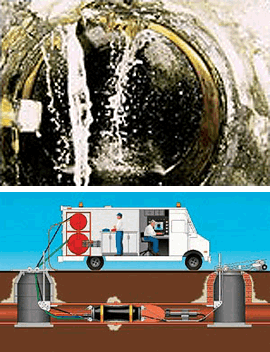Our combination digital television inspection/sewer joint sealing service provides a guaranteed solution to the problem of excessive infiltration, without costly excavation, disruption of traffic, or by-pass pumping of sewage.
When a leak is located by the television camera, our technician stationed in a mobile laboratory at the job site can isolate and seal the leak, usually in less than a minute. Pipe condition, type of leak, type of soil, chemicals present in the sewage and groundwater pressure are all factors that are considered before selecting a chemical/catalyst combination that is most suitable for each individual job.
Check the Numbers
Suppose you have a 300-foot section of 8-inch pipe with 3-foot joints, and 20% of the joints are leaking 1-gallon per minute.
- Infiltration into your system equals 10,512,000 gallons per year.
- Using a conservative cost estimate of $2.00 per thousand gallons to treat the water, you are spending $57.60 per day. That’s over $21,000 annually on this 300-foot section.
- The industry average cost for grouting is $8-$12 per foot. By grouting this same section at a cost of $10 per foot, your grouting expense will total $3,000.
- In just 53 days you will have recouped your initial investment of $3,000 and at the end of the first year you will have saved over $18,000 in unnecessary treatment costs.
- Over a ten-year period, your $3,000 investment will generate $207,240 in savings.
Sealing of laterals with chemical grouting
Carylon companies specialize in sealing lateral connections using chemical grout. Working from the mainline, we quickly and effectively seal leaks in service laterals in unlined pipe as well sealing the annular gap in lined pipes at the lateral connections. The grout is chemically formulated specifically for sewer applications, including acrylamide grout complying with ASTM F2304. Using a CCTV camera, the operator located the lateral and centers an inflatable grout packer over the areas to be sealed. He inflates the packer and injects chemical grout through the joints and into the surrounding soils, forming a watertight collar on the exterior of the pipe, effectively sealing the line and preventing future root intrusion. The lateral is then tested to ensure all leaks have been properly sealed.






